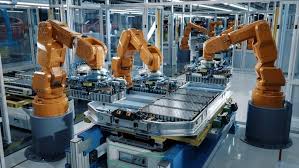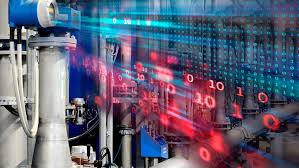Industrial automation refers to the use of control systems, such as computers or robots, for managing different processes in an industrial plant. This includes machinery, processes in factories, boilers, switching on telephone networks, steering ships, aircraft, and other applications. Industrial automation improves the efficiency, reliability, and safety of manufacturing systems while reducing the need for human intervention.
In recent years, industrial automation has transformed the manufacturing sector, leading to cost savings, improved productivity, and the development of smarter processes. As industries grow more complex, industrial automation systems continue to evolve, integrating advanced technologies such as AI, IoT, and machine learning.
1. Key Benefits of Industrial Automation
Industrial automation provides several key advantages to manufacturing processes. These benefits significantly enhance production output while lowering operational costs. Below are some primary benefits:
| Benefit | Description |
|---|---|
| Increased Productivity | Automation ensures that processes run continuously, reducing downtime and improving output. |
| Improved Product Quality | Automated systems can deliver consistent quality with fewer errors. |
| Cost Savings | Reduced labor costs and fewer errors lead to substantial savings in the long run. |
| Enhanced Safety | Automation removes workers from dangerous environments, minimizing the risk of injury. |
| Better Data Collection | Automation systems provide real-time data that help in decision-making and troubleshooting. |
By leveraging these benefits, businesses can streamline their operations, making them more competitive in an increasingly globalized market.
2. Components of an Industrial Automation System
An industrial automation system is composed of several key components, all working together to optimize production and improve operational efficiency. The main elements of such a system include:
2.1 Programmable Logic Controllers (PLCs)
PLCs are specialized computers used to control machinery and processes in industrial environments. They are highly reliable and used to automate tasks that are usually done manually. PLCs are essential in controlling machines such as conveyors, pumps, and assembly lines.
2.2 Sensors and Actuators
Sensors gather data from the environment, such as temperature, pressure, or motion, and send it to the control system for processing. Actuators, on the other hand, are devices that receive signals from the control system and initiate physical actions like opening a valve or starting a motor.
2.3 Human-Machine Interface (HMI)
HMIs are the visual interface that allows human operators to monitor and interact with the automation system. HMIs display data collected from sensors and allow operators to make adjustments as necessary.
2.4 Robots and Robotics Systems
Industrial robots are automated machines used for repetitive tasks, such as welding, painting, or packaging. Robots are programmed to perform specific functions with high precision, often outperforming humans in speed, accuracy, and endurance.
| Component | Role in Industrial Automation |
|---|---|
| PLCs | Control machines, monitors inputs and outputs, and executes commands. |
| Sensors | Gather environmental data, providing real-time information for the system. |
| Actuators | Perform actions based on commands, such as moving objects or adjusting settings. |
| HMIs | Interface between humans and machines, providing visual data and control options. |
| Robots | Perform tasks automatically, increasing speed and accuracy. |
These components work in tandem to ensure that manufacturing processes are carried out smoothly and efficiently.
3. Types of Industrial Automation Systems
Industrial automation systems vary depending on the complexity and scale of the application. Broadly, there are two main types of industrial automation: fixed and flexible.
3.1 Fixed Automation
Fixed automation, also known as hard automation, is used in mass production systems where the production process remains constant. This type of system is highly efficient for manufacturing large quantities of the same product and is commonly used in industries such as automotive manufacturing.
3.2 Flexible Automation
Flexible automation, also known as soft automation, allows for more flexibility in production. It can quickly switch between different tasks, making it ideal for environments where production runs are shorter, or product specifications frequently change. Industries such as electronics and consumer goods manufacturing typically utilize flexible automation.
3.3 Hybrid Automation
Hybrid automation systems combine elements of both fixed and flexible automation. This system is particularly beneficial for businesses that need to balance mass production with the need for product variety. Hybrid automation can be found in industries like food and beverage processing.
4. Industrial Automation and Industry 4.0
The rise of Industry 4.0 represents the next phase in industrial automation. Industry 4.0 involves the integration of cyber-physical systems, IoT, big data, and AI to create smart factories. Here are some of the ways Industry 4.0 is transforming industrial automation:
- IoT Integration 🌐: The Internet of Things (IoT) enables machines and devices to communicate with each other, providing real-time data that can be analyzed to optimize operations.
- Artificial Intelligence (AI) 🤖: AI is used to enhance decision-making and predictive maintenance. By analyzing data, AI can anticipate equipment failures before they occur, minimizing downtime.
- Robotics and Machine Learning 🦾: Robotics continues to advance with machine learning capabilities, allowing robots to improve their performance over time based on the data they collect.
Industry 4.0 is revolutionizing how factories operate, creating fully connected and intelligent systems that can self-optimize and adapt to changing conditions.
5. The Future of Industrial Automation
The future of industrial automation is bright, with ongoing advancements in technologies such as AI, robotics, and IoT driving innovation. Below are some of the key trends that will shape the future of industrial automation:
- Increased Use of Cobots 🤝: Collaborative robots, or cobots, are designed to work alongside humans. These robots are expected to become more common in manufacturing environments, enhancing productivity and safety.
- Artificial Intelligence 🤖: AI will continue to play a pivotal role in decision-making, predictive maintenance, and optimization, making automation smarter and more efficient.
- Edge Computing 📡: Edge computing allows data to be processed closer to where it is generated, improving response times and reducing latency in automated systems.
- Sustainability in Automation 🌱: As businesses focus on sustainability, energy-efficient automation systems that reduce waste and energy consumption are expected to become more widespread.
Industrial automation is rapidly evolving, offering a range of benefits that can significantly improve productivity, safety, and efficiency in manufacturing. As technology advances, the integration of AI, IoT, and robotics will continue to drive innovation, paving the way for smarter and more adaptable factories. Understanding the components, types, and trends in industrial automation is crucial for businesses looking to stay competitive in the modern industrial landscape. By adopting the right automation solutions, companies can optimize their operations, reduce costs, and meet the demands of an ever-changing market.
